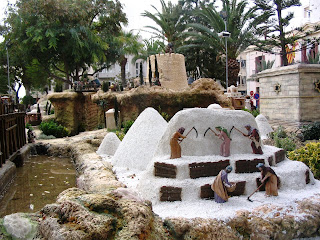
It's the eleventh day of Christmas. Since last Sunday in Spain we've managed a few other festivals. The Day of the Innocents is a sort of Spanish April Fool's Day.
Las Moragas in Roquetas de Mar is a giant beach-front afternoon and evening picnic, where groups light bonfires and cook fish in honor of the town's past life as a fishing village. Of course, we've also observed New Year's Eve and Day. Also during the week we went downtown in Torrevieja to view the annual municipal
Belén, literally, Bethlehem.
The
Belenes, which appear in every town during the Christmas season, are in the tradition of nativity scenes, but much more. A
Belén shows not only Jesus, Mary, and Joseph in the stable, not only the shepherds watching their flocks by night, not only the Wise Men coming from distant lands to Bethlehem.
Belenes are small-scale reproductions of entire towns in ancient times. So you will see common houses with cooking facilities and laundry hanging on a clothes line, a bakery, the outdoor market, perhaps a school, carts and animals, and always something unique to the town in which the particular
Belen has been constructed.
The Torrevieja
Belén filled more than a third of the area of a city block in the plaza in front of the church and town hall. The landscapes and buildings, with bonsai-sized vegetation and miniature human figures, were mounted on waist-high tables in a long rectangle. Some observers proceeded in an orderly fashion through the entire story around the rectangular block. Others milled in and out to view specific scenes, which were not necessarily in historical sequence. The Torrevieja
Belén showed more religious history than I have seen before in a
Belen, or perhaps I recognized more because scenes were labeled: the tax decree, Mary visiting her sister Isobel, the couple asking for lodging at the inn, the announcement to the shepherds, the three kings on their travels, Jesus at the temple, the flight to Egypt.
Each town has its own
Belén, and part of the tradition is to celebrate the daily life of the specific municipality itself in ancient times. Torrevieja got its industrial and commerci

al start from its two salt lakes--the industry continues and people tell me that Torrevieja still supplies salt for the removal of snow from New York City streets. So the
Belén showed laborers hacking out salt and loading it up for transportation. Especially in the eastern areas of Spain, I learned this year, at least one scene is created to connect the spiritual with the mundane. The Torrevieja
Belén showed the consternation of a driver of a horse-drawn cart, fully laden, that had just lost one of its wheels, and in another scene, someone had slipped on steps and was tumbling head over heels. A nearby town, I understand, offered a young man relieving himself behind a tree.
You can find
Belenes in many places during the holiday season: department stores, hotels, restaurants, offices, senior citizen dwellings. The largest and most elaborate
Belén in each community is sponsored by the local government--not the church. No concern about mixing church and state in this regard! Since the death of Franco (1975), sentiment has grown against Catholicism and the Church, which was complicit in his dictatorship. Spain has officially guaranteed its citizens religious freedom since the 1978 Constitution. But no one demonstrates against the
Belenes. In fact, there are competitions and museums to highlight the best. The
Belenes show history, and Spaniards acknowledge, respect, and hold in affection the common history of mankind as they see it in the
Belén.



